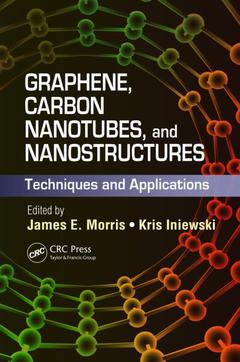Graphene, Carbon Nanotubes, and Nanostructures Techniques and Applications Devices, Circuits, and Systems Series
Coordonnateurs : Morris James E., Iniewski Krzysztof

Graphene, Carbon Nanotubes, and Nanostructures: Techniques and Applications offers a comprehensive review of groundbreaking research in nanofabrication technology and explores myriad applications that this technology has enabled.The book examines the historical evolution and emerging trends of nanofabrication and supplies an analytical understanding of some of the most important underlying nanofabrication technologies, with an emphasis on graphene, carbon nanotubes (CNTs), and nanowires.
Featuring contributions by experts from academia and industry around the world, this book presents cutting-edge nanofabrication research in a wide range of areas. Topics include:
- CNT electrodynamics and signal propagation models
- Electronic structure calculations of a graphene?hexagonal boron nitride interface to aid the understanding of experimental devices based on these heterostructures
- How a laser field would modify the electronic structure and transport response of graphene, to generate bandgaps
- The fabrication of transparent CNT electrodes for organic light-emitting diodes
- Direct graphene growth on dielectric substrates, and potential applications in electronic and spintronic devices
- CNTs as a promising candidate for next-generation interconnect conductors
- CMOS?CNT integration approaches, including the promising localized heating CNT synthesis method
- CNTs in electrochemical and optical biosensors
- The synthesis of diamondoids by pulsed laser ablation plasmas generated in supercritical fluids, and possible applications
- The use of DNA nanostructures in lithography
- CMOS-compatible silicon nanowire biosensors
- The use of titanium oxide-B nanowires to detect explosive vapors
- The properties of protective layers on silver nanoparticles for ink-jet printing
- Nanostructured thin-film production using microreactors
A one-stop reference for professionals, researchers, and graduate students working in nanofabrication, this book will also be useful for investors who want an overview of the current nanofabrication landscape.
Carbon Nanotubes: From Electrodynamics to Signal Propagation Models. Quasi-Particle Electronic Structure of Pristine and Hydrogenated Graphene on Weakly Interacting Hexagonal Boron Nitride Substrates. On the Possibility of Observing Tunable Laser-Induced Bandgaps in Graphene. Transparent and Flexible Carbon Nanotube Electrodes for Organic Light-Emitting Diodes. Direct Graphene Growth on Dielectric Substrates. Aligned Carbon Nanotubes for Interconnect Application. Monolithic Integration of Carbon Nanotubes and CMOS. Applications of Carbon Nanotubes in Biosensing and Nanomedicine. Synthesis of Higher Diamondoids by Pulsed Laser Ablation Plasmas in Supercritical Fluids. Molecular Lithography Using DNA Nanostructures. CMOS-Compatible Nanowire Biosensors. Trace Explosive Sensor Based on Titanium Oxide-B Nanowires. Properties of Different Types of Protective Layers on Silver Metallic Nanoparticles for Ink-Jet Printing Technique. Fabrication of Nanostructured Thin Films Using Microreactors. Index.
Jim Morris is an electrical and computer engineering professor at Portland State University, Oregon and is an IEEE fellow. Dr. Morris has served as treasurer of the IEEE Components Packaging and Manufacturing Technology (CPMT) Society (1991-1997), BoG member (1996-1998, 2011-2013), VP for conferences (1998-2003), distinguished lecturer (2000-present), CPMT Transactions associate editor (1998-present), and IEEE Nanotechnology Council (NTC) representative (2007-2012), and won the 2005 CPMT David Feldman Outstanding Contribution Award. He also serves as the NTC VP for conferences (2013-2014) and awards chair (2011-2013). He has edited or co-authored five books on electronics packaging, including one on nanopackaging.
Krzysztof (Kris) Iniewski manages R&D at Redlen Technologies, Inc., a startup company in Vancouver, Canada. He is also a president of CMOS Emerging Technologies, an organization of high-tech events covering communications, microsystems, optoelectronics, and sensors. Dr. Iniewski has held numerous faculty and management positions at the University of Toronto, University of Alberta, SFU, and PMC-Sierra, Inc. He has published more than 100 research papers in international journals and conferences. He holds 18 international patents granted in the United States, Canada, France, Germany, and Japan. He is a frequent invited speaker, has consulted for multiple organizations internationally, and has written and edited several books.
Date de parution : 03-2013
15.6x23.4 cm
Disponible chez l'éditeur (délai d'approvisionnement : 15 jours).
Prix indicatif 232,80 €
Ajouter au panierDate de parution : 04-2017
15.6x23.4 cm
Disponible chez l'éditeur (délai d'approvisionnement : 14 jours).
Prix indicatif 96,92 €
Ajouter au panierThèmes de Graphene, Carbon Nanotubes, and Nanostructures :
Mots-clés :
Dirac Point; carbon nanotubes; Kinetic Inductance; graphene bandgaps; CNT; tunable laser; CNT Interconnect; OLED carbon nanotube electrodes; PDMS Stamp; graphene dielectric substrate; American Chemical Society; carbon nanotubes interconnects; DNA Nanostructures; integration of carbon nanotubes; CNT Growth; CNT-CMOS; Band Gap; biosensing carbon nanotubes; DNA Origami; carbon nanotubes in nanomedicine; Nanowire Surface; diamondoid synthesis; Quantum Capacitance; molecular lithography using DNA nanostructures; Continuous Flow Microreactor; CMOS-compatible nanowire biosensors; Hydrogenated Graphene; silicon nanowire biosensor; CdS Thin Film; titanium oxide nanowire; OLED Device; trace explosive sensors; CNT Thin Film; inkjet printing silver nanoparticles; CNT Shell; nanostructured thin films and microreactors; CNT Film; Antonio Maffucci; SiNW FET; Sergey A; Maksimenko; Higher Diamondoids; Giovanni Miano; FTIR Spectrum; G.Ya; Slepyan; Pulsed Laser Plasmas; Neerav Kharche; CNT Electrode; Saroj K; Nayak; SWCNT Thin Film; HernL; Calvo; Horacio M; Pastawski; Stephan Roche; Luis E.F; Foa Torres; Yu-Mo Chien; Ricardo Izquierdo; Jeffry Kelber; Yang Chai; Minghui Sun; Zhiyong Xiao; Yuan Li; Min Zhang; Philip C.H; Chan; Huikai Xie; Ying Zhou; Jason Johnson; Ant Ural; Aihua Liu; Huajun Qiu; Sven Stauss; Sho Nakahara; Toru Kato; Takehiko Sasaki; Kazuo Terashima; Sumedh P; Surwade; Haitao Liu; Thanh C; Nguyen; Wanzhi Qiu; Matteo Altissimo; Paul G; Spizzirri; Laurens H; Willems van Beveren; Efstratios Skafidas; Danling Wang; Antao Chen; Andrzej Mościcki; Anita Smolarek; Jan Felba; Tomasz Fałat; Chih-hung Chang; Brian K; Paul; Si-Ok Ryu



